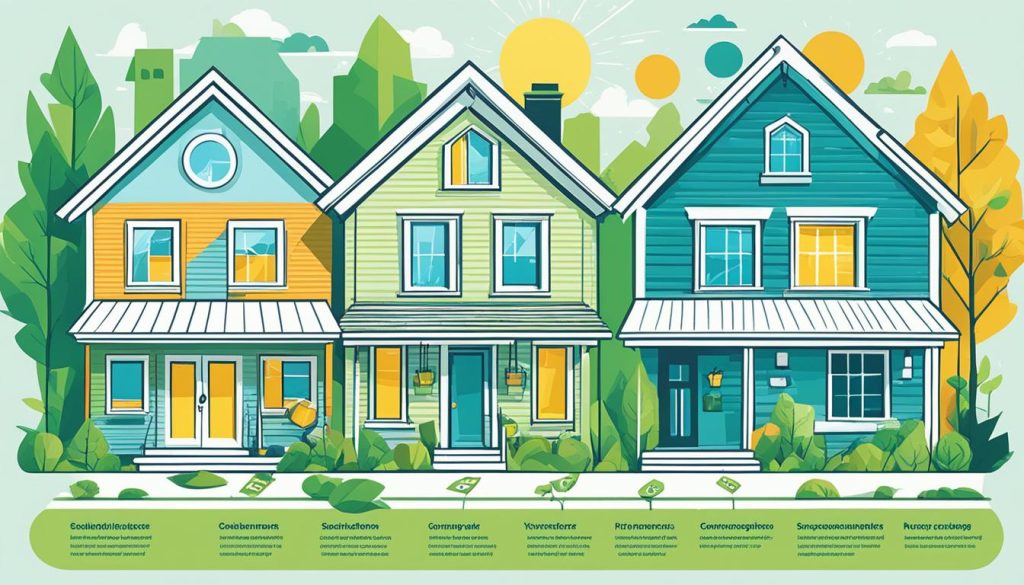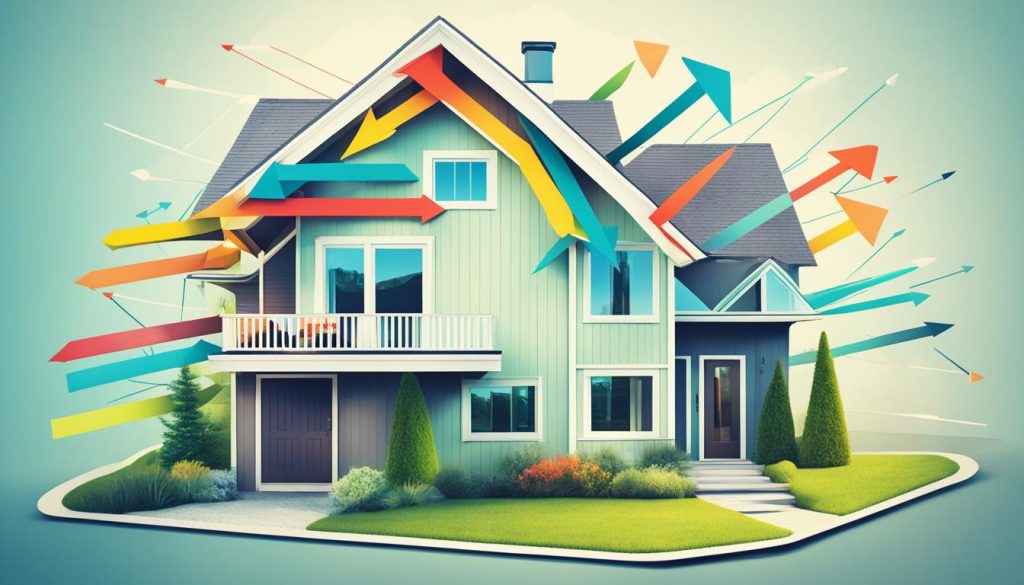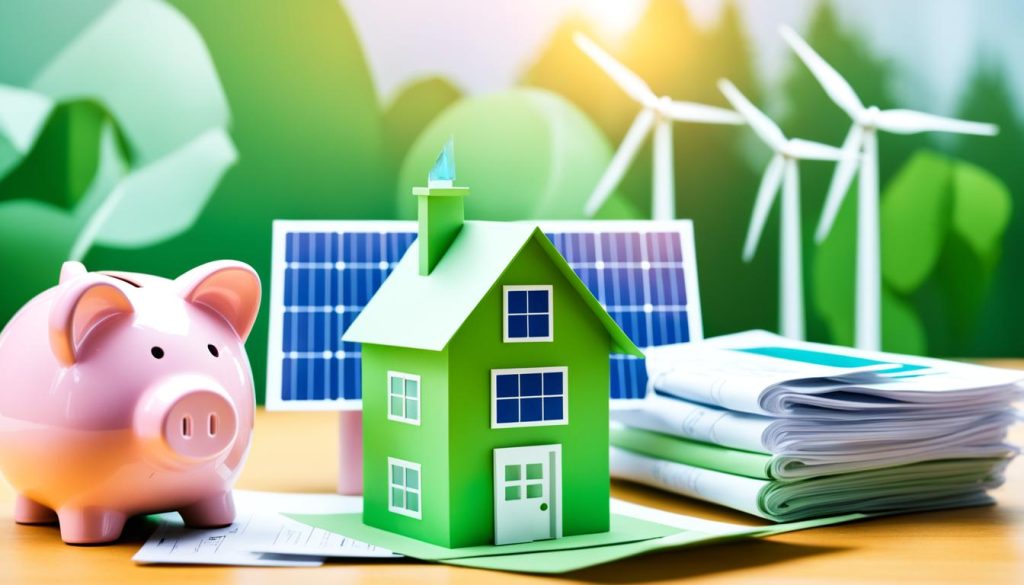Owning an energy-efficient home can save you money on bills and help the planet. Energy Efficient Mortgages (EEMs) help homeowners pay for green upgrades. They are part of your mortgage or refinancing. These mortgages consider how much you’ll save on energy costs, offering better terms1.
EEMs come from the FHA, VA, USDA, and the conventional mortgage market. They let homeowners buy energy-efficient homes or upgrade their current ones. The aim is to cut down on energy use and lower bills1.
Key Takeaways
- EEMs let homeowners finance green upgrades as part of their mortgage or refinancing.
- They’re backed by federal programs and the conventional market, offering various financing options.
- EEMs consider how much you’ll save on energy, making better terms possible for borrowers.
- Homeowners can use EEMs for new energy-efficient homes or upgrades, reducing their environmental impact and bills.
- EEMs make energy-efficient homes more reachable and affordable for homeowners.
What is an Energy Efficient Mortgage (EEM)?
An Energy Efficient Mortgage (EEM) helps homeowners pay for energy-saving upgrades and green home improvements2. It looks at the value of saving energy and uses that to help you get a bigger loan or better terms2. This makes owning a home more affordable over time3.
Understanding the Concept and Benefits
EEMs give homeowners extra money for things like solar panels, wind technology, and better insulation3. These upgrades must save more money than they cost, making your home cheaper to run3. This way, EEMs can help you get a bigger loan or better terms, saving you money in the long run3.
The program started as a small test in 1992 and grew into a national program by 19952. Now, you can get EEMs through the FHA EEM and VA EEM, each with its own rules and options3.
To get an EEM, you need a home energy check-up from a certified expert2. For new homes, the energy work must meet the latest energy code set by HUD2.
With an Energy Efficient Mortgage, you can make your home use less energy. This means lower bills and helping the planet3.
Types of Energy Efficient Mortgages
There are many types of energy efficient mortgages (EEMs) for homeowners. These loans let you include costs for things like insulation, windows, solar panels, and energy-efficient appliances in your mortgage4.
Conventional Energy Efficient Mortgages
Conventional EEMs let you finance upgrades up to 15% of your home’s value5. These mortgages can boost your home’s value and cut down on greenhouse gas emissions by making it more energy efficient4.
FHA Energy Efficient Mortgage Program
The FHA EEM program lets you stretch your qualifying ratios up to 2 points for energy-efficient homes5. This means you can buy a bigger home or finance energy-saving upgrades with your mortgage4.
VA Energy Efficient Mortgage
The VA EEM program helps Veterans and their families pay for energy-efficient home improvements5. You can add up to $6,000 in upgrades to your mortgage loan5. The savings on energy bills can pay for these upgrades over time4.

These are just a few examples of energy-efficient mortgages. Homeowners looking to save on energy costs should check out these options to find the best one for their budget4.
Qualifying for an Energy Efficient Mortgage
To get an Energy Efficient Mortgage (EEM), homeowners need to meet certain requirements and get a detailed home energy check-up1. A pro will look at how energy-efficient the home is now and suggest ways to save more energy1.
For an EEM, the savings from energy upgrades must be as much as or more than the cost of those upgrades1. This makes sure the upgrades are worth it and will save the homeowner money6.
Applicants must also meet the financial rules for their mortgage type, just like with a regular mortgage1. This includes things like credit score, debt-to-income ratio, and down payment6.
Eligibility Requirements and Assessments
- Home energy check-up by a pro to see how efficient it is and find ways to improve1
- Energy-saving upgrades must save as much energy as they cost1
- Meet the financial rules for the mortgage type, similar to a regular mortgage1
By meeting these rules and getting a detailed home energy check-up, homeowners can get an Energy Efficient Mortgage6. This money can help pay for upgrades that make the home use less energy. These upgrades save money over time and help the planet6.
| Mortgage Type | EEM Financing Limits |
|---|---|
| Conventional EEM | Up to 15% of home’s appraised value for energy-efficient improvements1 |
| FHA EEM | Up to 5% of adjusted value of the property or 150% of the national conforming mortgage limit1 |
| VA EEM | Up to $6,000 on top of the approved loan amount1 |
| USDA Single Family Housing Guaranteed Loan Program | 100% financing for eligible households in rural areas1 |

“Homeowners with lower utility bills can allocate a larger portion of their income to housing expenses.”6
Financing Options for green home improvements, energy-saving upgrades, financing options
If you don’t qualify for an Energy Efficient Mortgage (EEM), there are still ways to fund your green home improvements. These options can help you make your home more sustainable and save energy.
A cash-out refinance lets you use your home’s equity for renovations7. You could get up to $25,000 for energy-saving upgrades or clean energy gear7. Another choice is a home equity loan, using your home’s equity as security8. These loans can range from $1,000 to $50,000, perfect for green upgrades.
EEMs have special benefits for energy-efficient upgrades, but these alternatives can also help8. With FHA loans, you can put down just 3.5% for eco-friendly home improvements8. VA loans offer financing for green upgrades for military members and veterans too.
| Financing Option | Key Features |
|---|---|
| Cash-out Refinance | Tap into home equity to fund upgrades, up to $25,000 in loans7 |
| Home Equity Loan | Use home equity as collateral, personal loan amounts up to $50,0008 |
| FHA Loans | Low down payment of 3.5% for eco home improvements8 |
| VA Loans | Financing available for green home improvements for military and veterans8 |
Choosing any financing option can cut your home’s environmental impact and lower energy costs8. The average household spends about $2,000 a year on energy. Simple changes like sealing drafts and better insulation can save 5% to 30% a year8.
Energy-Efficient Home Improvements and Upgrades
Examples of Eligible Improvements
Investing in energy-efficient home improvements can cut your energy use and lower your bills. An Energy Efficient Mortgage (EEM) helps finance upgrades like energy-saving appliances and HVAC replacements9. These changes make your home more eco-friendly and add value.
You can get federal tax credits up to $3,200 a year for certain upgrades9. The Residential Clean Energy credit gives you a 30% tax credit for clean energy systems like solar and geothermal pumps until 20329. After 2032, it drops to 22%, and then to 10% in 20349. You can also save up to $2,000 by switching to heat pump technology9.
According to the National Association of Homebuilders (NAHB), most homebuyers want homes with energy-saving features and lower bills over cheaper ones without10. Energy Star says 25-40% of heating and cooling energy is lost through leaks, making insulation key10. You can get back 35-71% of a new HVAC system’s cost, depending on the study10.
EEMs can help you improve your home’s energy efficiency, lower your carbon footprint, and boost its value10. By planning your upgrades, you can get the most from your tax credits and save on bills for years9.
Combining EEMs with Other Programs
Homeowners can mix Energy Efficient Mortgages (EEMs) with other programs for green home upgrades. This mix can boost benefits and open up more chances for sustainable home fixes.
FHA 203(k) Rehabilitation Mortgage
Pairing an EEM with the FHA 203(k) Rehabilitation Mortgage is a smart choice. This program helps finance many home improvements, like an “Energy Package” from an EEM2. The energy package can be the cost of improvements or up to 5% of the home’s value2. This way, homeowners can improve energy efficiency and fix up their homes with one loan.
Solar and Wind Technologies
Homeowners can also blend EEMs with FHA’s policies on Solar and Wind Technologies. These policies let borrowers borrow more to cover solar or wind system costs11. Solar leases don’t need upfront payment but can be costly over time11. PACE financing covers up to 15% of a home’s value or $700,000, with interest rates from 4.75% to 9%11. Adding renewable energy to home improvements boosts a property’s energy efficiency and sustainability.
Being able to mix EEMs with programs like the FHA 203(k) and solar/wind tech financing lets homeowners upgrade efficiently. This approach improves a home’s energy use and value. It also offers various financing options for different needs and budgets.
Conclusion
Energy Efficient Mortgages (EEMs) are a great way for homeowners to make their homes greener and more sustainable12. They let you finance green upgrades and save on utility bills13. EEMs help homeowners invest in upgrades that cut down on energy use and save money over time.
There are different types of EEMs, like conventional, FHA, and VA programs12. These options help homeowners reach their green goals. You can improve your home’s energy efficiency with things like insulation, renewable energy, and HVAC upgrades12. With lower interest rates, loan programs, and tax breaks, you can make your home both eco-friendly and smart financially.
In summary, EEMs are a smart choice for financing green upgrades and saving on energy13. They offer benefits like lower bills, a higher home value, and less environmental harm. By choosing an EEM, you get to enjoy a more comfortable and efficient home.
FAQ
What is an Energy Efficient Mortgage (EEM)?
An Energy Efficient Mortgage (EEM) is a loan that helps homeowners pay for energy-saving upgrades. It gives extra funds for making homes more energy-efficient. This can lead to big savings on monthly bills.
What are the different types of Energy Efficient Mortgages?
Homeowners can choose from several Energy Efficient Mortgages. These include conventional EEMs, FHA EEMs, and VA EEMs. Each type has its own rules and benefits.
What are the requirements to qualify for an Energy Efficient Mortgage?
To get an EEM, homeowners need a home energy check-up from a pro. The upgrades must save more energy than they cost over time. Borrowers must also meet the financial needs of their mortgage type.
What if I don’t qualify for an Energy Efficient Mortgage?
If an EEM isn’t an option, there are other ways to finance green upgrades. You could consider a cash-out refinance, a home equity loan, or a personal loan.
What types of energy-efficient home improvements and upgrades can I finance with an EEM?
EEMs can fund many energy-saving upgrades. This includes new energy-efficient appliances, windows, HVAC systems, insulation, weatherization, and roofing improvements.
Can I combine an Energy Efficient Mortgage with other home improvement and financing programs?
Yes, you can mix EEMs with other programs like the FHA 203(k) Rehabilitation Mortgage. This can help homeowners get the most benefits.
Source Links
- Energy-Efficient Mortgages
- HUD FHA Insured Energy Efficient Mortgages
- What is an Energy-Efficient Mortgage (EEM)? | Chase
- What Is An Energy Efficient Mortgage (EEM)? | CrossCountry Mortgage
- What Is An Energy-Efficient Mortgage? – NerdWallet
- Energy Efficient Mortgage Homeowner Guide – HUD
- Residential Financing Programs – NYSERDA
- How to Finance Your Eco Home Improvements | LendingTree
- Federal Tax Credits for Energy Efficiency
- The 8 Best Energy Efficient Home Upgrades
- 6 Ways to Finance Energy Efficient Upgrades for Your Home – Mylene Merlo – North County San Diego Real Estate Advisor
- Where To Find Affordable Financing for Energy-Efficiency Upgrades
- The mortgage that will pay to make your home more climate friendly

